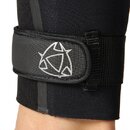Nope.
The tear reaistance of nitrile exceeds the tear resistance of trilaminate material.
Specifically, the SHOWA 720 has an EN388 tear resistance of 4 out of 6, which is an amazingly high number - and the highest number I've seen in a drysuit glove. For more info on EN388 hazard reaistance numbers, see this link:
https://www.hsimagazine.com/article/en388-standard-469
In other words... If you wanted to keep a strap like that to provide a solution in case of a catastrophic suit flood, it'd be more for the possibility of tearing your drysuit than for tearing a glove... Since that would be a bigger failure point.
My solution to the possibilty of tearing a suit has been twofold:
1. Dive a suit made of hypercompressed or crushed neoprene (not "compressed" neoprene). I dive the BARE Sentry, which I helped design for BARE and is newly available to the public. Only it and the DUI CF200 use this type of material, which is by far the toughest, most tear resistant fabric available in a drysuit. Prior to the Sentry, I dove the BARE XCS2, which uses a very similar and tough fabric.
2. Maintain proper bouyancy throughout the dive. The best way to prevent damage to any drysuit is to stay off of sharp things.
So far, it's working. I've got something like 1,200 hours underwater over the past couple years in hypercompressed neoprene drysuits equipped with SHOWA 720s, cleaning oysters and barnacles off of boat bottoms, cutting pilings with chainsaws, reciprocating saws, and angle grinders, and doing salvage work (where there's always sharp edges). I can count on one hand how many times I've holed a glove - which I usually don't know about until I doff the glove. I've never holed a hypercompressed neo suit, even though I've bumped and scraped and damaged them plenty. I've never torn either or experienced a catastrophic flood - regardless of whether I had wrist seals intact or removed (cut back).
If you're doing staged decompression, you're probably diving a wrist computer like a Shearwater or something similar. The computer has either bungees or elastic straps that hold it in place. If you were to suffer a catasrophic flood, in an emergency you could use those to help block additional suit flooding... Just move the computer to the affected limb and end the dive.
If you're not doing staged decompression, simply surface and end the dive.
...But so far - in the worst of conditions - I haven't experienced it.
...So no, I don't bother with a strap.





